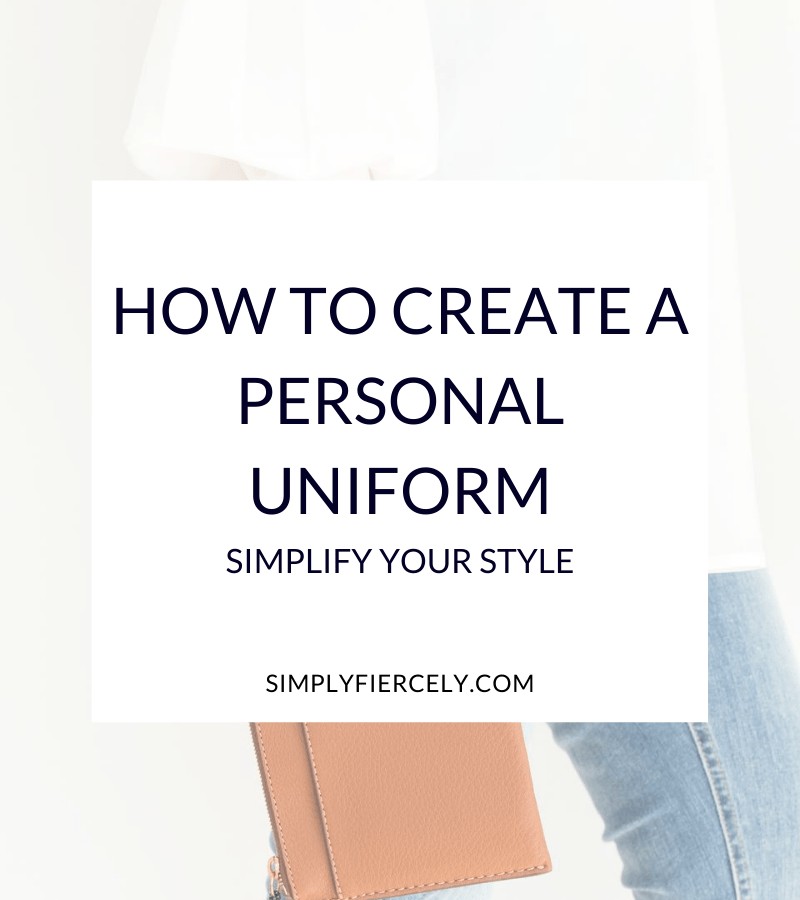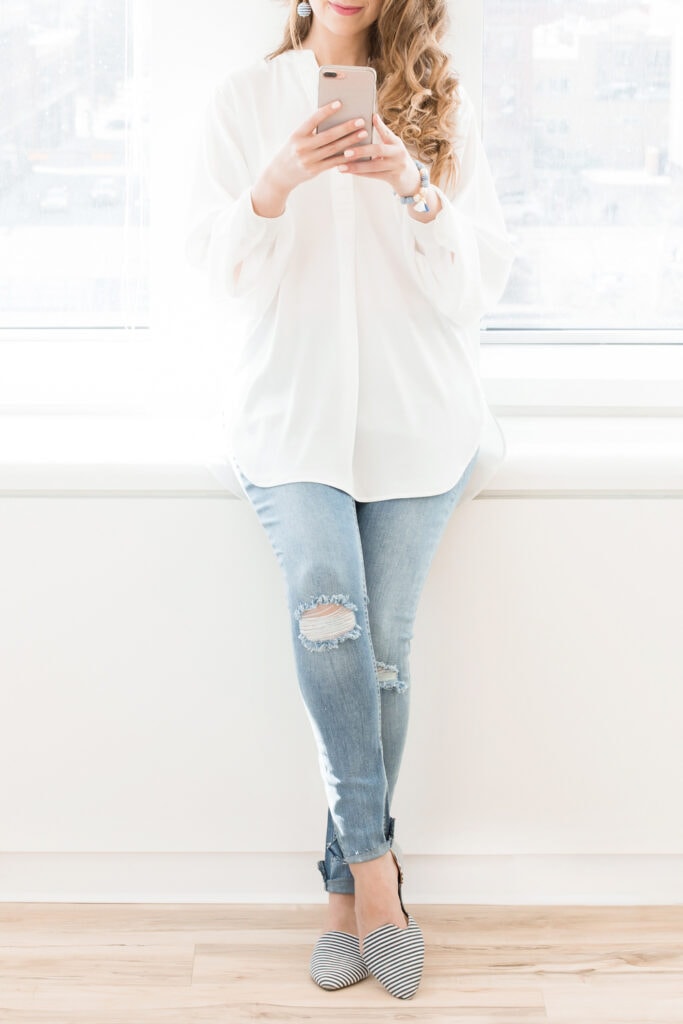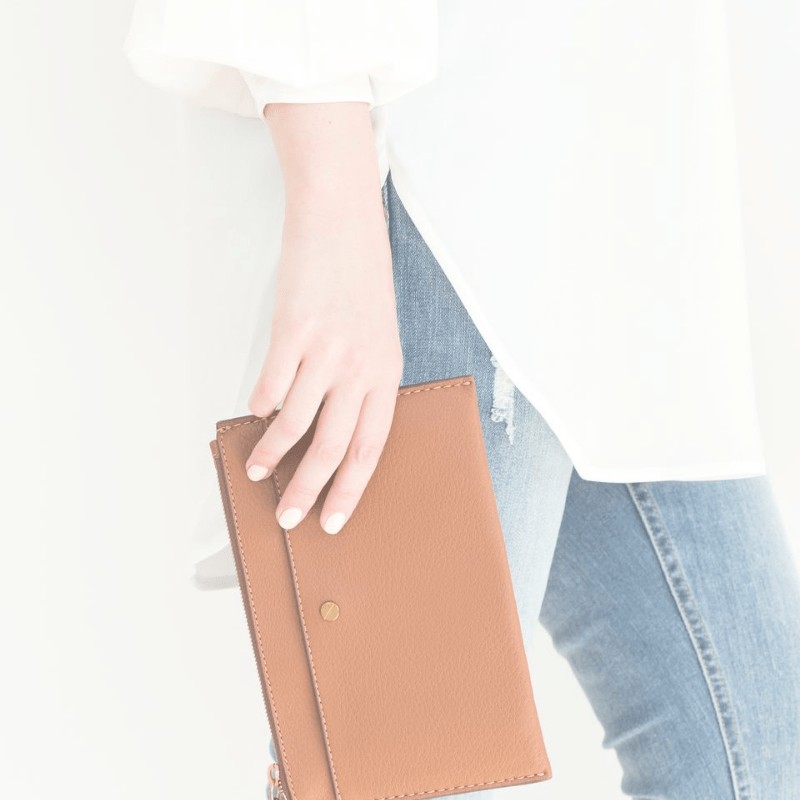Would you like to simplify your style and make getting dressed every day easier? If so, I highly recommend that you create a personal uniform.
A personal uniform is a “go-to” style that you love wearing, and it’s an easy way to take the stress out of choosing your outfits. Find a formula that works for you, and you can rest assured that you’ll be comfortable and confident every day.
This guide has step-by-step instructions to help you get started, as well as examples to inspire your own minimalist wardrobe.

Why You Should Have a Personal Uniform
In case you’re not entirely sold on the idea yet, let me quickly recap the benefits of a personal uniform.
First and foremost, it makes your life easier because you have fewer decisions to make. I know that you probably have a lot on your mind and it can be exhausting. You need to conserve your brain for important decisions, and getting dressed shouldn’t be one of them.
Also, we all want to feel comfortable and confident in our clothes. There’s nothing worse than leaving the house and then realising you’ve made a mistake.
I’ve done this SO many times in the past—from choosing a skirt that doesn’t fit right or a colour that doesn’t suit my skin. I know that in theory, clothes are just clothes and they shouldn’t matter, but in reality, what we wear has a significant impact on how we feel.
When you have a style uniform, everything you wear has been tried and tested. You know you’re going to feel good in your clothes because you’re not reinventing the wheel. You’re sticking with what works, and it’s empowering.
Which brings me to my final point—when you have a personal uniform, you know exactly what you like, so you stop buying clothes you don’t wear. You’re focused and less distracted by trends. Instead, you have your own style, and it shows.
Should I Wear the Same Thing Every Day?
Ok—so there’s clearly a lot of benefits to having a personal uniform but some of you might be wondering if it means wearing the exact same thing every day.
The answer is no.
Of course, you can if you want to (like Steve Jobs, who is famous for always wearing a black turtleneck, jeans and sneakers). It’s undoubtedly simple, but personally, I like a bit of variety in my wardrobe and I know you probably feel the same way.
Don’t worry; a personal uniform allows for flexibility.
Think of it like … a taco.
There’s a basic formula: tortilla + main filling + toppings. Every taco has these same ingredients, but there’s still room for creativity! You can choose a hard or soft shell, corn or flour tortilla, beef, pork, fish … and don’t get me started with the toppings.
There are so many ways you can put together a taco but it’s not complicated because the basic framework is always the same. You can get creative without the stress because you know it’s going to work.
The same applies to your style uniform. Once you create a basic “recipe” for your wardrobe, you can have fun and experiment without worrying how it will turn out.
Is a personal uniform the same as a capsule wardrobe? Not exactly. A personal uniform is the formula. You plug pieces from your capsule wardrobe into the formula to create outfits.
How To Create Your Own Personal Uniform
Ready to get started? This is the step-by-step process I used to create my personal uniform.
STEP 1: RECORD YOUR OUTFITS FOR TWO WEEKS
You can do this in a notebook, or it’s really easy to do using a notetaking app on your phone (like the free “Notes” app that comes with the iPhone).
Simply create a new note and then, using the camera from directly within the app, photograph your outfit each morning.
Then at the end of the day, open the same note and write a few lines reflecting on how you felt in your outfit. Did you feel confident, comfortable and at ease? If not, how did you feel?
I recommend doing this every day for at least two weeks or even longer. The more data you have, the easier it will be to see patterns (which will help inform your uniform).
Note: if you are using a notebook, you’ll need to write a description of your outfits instead of taking a photo. Be as specific as possible and include accessories.

STEP 2: REFLECT AND OBSERVE
After two weeks, take a look at the results, paying particular attention to the outfits you most enjoyed wearing. What did they all have in common? Look for things like fit, fabric, and colours.
Take notes and be specific because these are clues that will help uncover your style uniform. You’re working backwards to discover the outfit formula that makes you feel your best.
STEP 3: DECIDE ON A FRAMEWORK
Next, it’s time to decide on a framework—this the “shape” of your uniform.
(Using the food analogy, this is where you decide to be a taco and not a stir-fry.)
Here are some examples, but remember—use your data to inform your decision. You want to choose a formula that is proven to work, not something you aspire to wear.
- A full, knee-length skirt with a fitted blouse
- Slim fitting trousers paired with an oversized top
- Skinny jeans with a long t-shirt
At this stage, don’t worry too much about colours, fabrics or prints. Instead, focus on the silhouette and proportions. What type of outfit do you want to wear?
Tip: It’s OK to have different uniforms to suit your lifestyle. For example, you might have a work uniform and weekend uniform. Or your work uniform might involve two different styles (you like wearing skirts AND trousers). There are no set rules—you can decide how simple you want your uniform to be.
STEP 4: CHOOSE COLOURS AND FABRICS
Now it’s time to consider your colours and fabrics. Here are some general rules—but again, feel free to mix things up if these don’t work for you.
- Choose one or two base colours. These are usually neutrals like black or navy.
- Choose 3-5 accent colours or prints that match your base colours. You want to be able to mix and match.
- This isn’t required but I recommend deciding on fabrics too. Think about what’s comfortable AND stylish.
STEP 5: PICK YOUR ACCESSORIES (OPTIONAL)
Finally, let’s consider your accessories. These include things like handbags, shoes and belts, as well as layering pieces such as cardigans, scarves or outerwear.
If you want to keep things simple, I recommend choosing a few favourites (taking into consideration your lifestyle). One way of doing this is by picking a signature colour for your bags, shoes and belts. This an easy way of making sure everything matches and it can help bring together a “look”.
Alternatively, if you’re the type who gets bored quickly, you don’t have to limit yourself. Accessories are a great way to get more mileage from your uniform. After all, a simple change of shoes can completely change your outfit!

Putting It All Together
When you’re finished, you should have a framework that you can use to make getting dressed easier.
For example, your work uniform might be:
- Framework – pencil skirt + blouse
- Base colour – black
- Accent colours – ivory, deep red, grey
- Print – red floral top
- Accessories – Black shoes and bag, red scarf, grey cardigan
- Fabrics – wool, cotton and silk
You could easily imagine a closet with two skirts (black and grey) and a variety of tops in the accent colours or print. If you mix and match, you’d easily have a week or two of outfits—more if you play with accessories.
Getting dressed would be effortless, you’d always look put together, and shopping would be a breeze. This is the power of a personal uniform.
MY PERSONAL UNIFORM
If you’re curious, my personal uniform is currently a work in progress. I had baby #2 a few months ago so I’m in the process of updating my wardrobe to work with my changing body.
I’m going to wait a bit longer because my size is still changing daily but I’m confident that I’ll end up decluttering and buying a few new things. I’m using this as an opportunity to solidify my style uniform, as follows:
- High waist jeans or shorts + a neutral tank top – I live in a subtropical climate, so I wear tank tops year-round. If it’s cold, I’ll add a sweater or button-down shirt.
- Black shorts or skirt + tank top – just a variation of the above!
- Black is obviously my base colour. My accent colours are grey, cream, green, blue and dark purple. My print is stripes.
- My fabrics are denim, linen, cotton and silk.
- Black or tan accessories (shoes, bags, belts) plus a few layering pieces.
I’ll post an update in a few months but for now, feel free to check out my minimalist wardrobe tour. It’s slightly outdated but my general style hasn’t changed too much.
Examples of Personal Uniforms
Are you looking for some examples to inspire you? Here are some of my favourites from around the web:
- I love these examples because it shows that uniform dressing doesn’t have to be boring. Some of these are traditionally “minimalist” (read: neutral) but there are also some fun examples that are full of colour.
- This princess obviously has a bigger wardrobe than most of us! But I love how she clearly has elements of a style uniform.
- Here’s a week of outfits using a super simple uniform (I’m really inspired by this one!)
Learn More About Minimalist Wardrobes
If this has inspired you to further simplify your style, check out:
- A Simple Guide to a Simple Wardrobe
- 20 Minimalist Wardrobe Tips: How to Have a Minimalist Closet
- How to Declutter Your Closet For Good: An Ultimate Guide
Do you dress with a personal uniform? If not, has this inspired you to simplify your stye? Let us know in the comments!

Hello!
I found your site (simplyfiercely.com) it extremely awesome! I wanted to know if you accept paid content in the form of guest posts and give a do-follow link to our client’s site.
Kindly let me know the price per post (if you are interested to sell sponsored posts on your blog).
Also, we might be interested in placing in-content text links (link from an existing blog post) please do let me know the price per text link placement as well.
So tell me the prices, and we’ll get an agreement ☺
Have a nice day!
Regards,
Kathryn
Outreach Manager at Webs cordial
I recently realized my wardrobe was mostly sweat/stretchy pants and oversize t-shirts which made dressing easier when I had 3 broken bones in a 2 year period. I have thinned out my clothes by trying on every single thing in my closet & donating what didn’t fit well or just didn’t feel good when I wore it. (I also donated all of the “some day” clothes I kept in a cĺoset in another room.) I am now going to track what I wear for two weeks & then make decisions about what to keep & buy based on the info I gain from that. Thank you for sharing this info/perspective.
Over the years and different family circumstances I have had several different personal uniforms. In college, women still could not wear pants on campus so a skirt or jumper with a blouse or sweater and jacket was the uniform. With young children, pants or skirts with a casual top and sweater or sweatshirt did the trick. As a senior citizen I feel most comfortable and positive about my looks with a skirt, a blouse or tee or sweater, and a weather appropriate jacket or over-blouse (or cardigan at home.) Long or flippy skirts are best. Dresses or matching two-piece outfits are a variation to perk up the uniform now and then. I love your analogy of the taco with maybe a sandwich now and then.
Went online this morning and found your site, it’s exactly what I hoped for!
Have always had a plan since I worked in the areas of finance and consulting most of my life. The executive look was a priority in specific industries and often still is.
Black, navy blue and some charcoal grey with brighter shots via scarves, red shoes and also small lapel pins etc. The Chic Simple book Women’s Wardrobe (1995) was my guide over the years and it really reflects my style. It’s not about having a lot of clothes and I was lucky to find a copy!
Now that I am (semi) retired my wardrobe is more casual but I had still been in the mode of stocking up when finding something I really like. Will still need a smaller dressy section for meetings etc. so not many pieces required. Had donated the majority of my business wardrobe to Dress For Success years ago.
This will be very helpful next week when clearing out my wardrobe is on the list.
Great job, thanks so much!
I am so going to develop my personal uniform. Thanks.
Yes, do it! 🙂
I went on eBay way too much and wound up with tons of different things that suggested I had sixteen personalities. Finally I got real about this and made a decision. Maybe those who read your email and blogs would benefit from my decision. I will say that this was far from easy. But here is what happened which led to the clarity. I had become attracted to the idea proposed by Carol Tuttle of Dressing Your Truth fame. I took pains to recognize who I was and wasn’t. But I say all this because it didn’t work. It wasn’t a mistake however because by the time I discovered I wasn’t really a type four and a secondary one, I think that’s when I had my epiphany. I asked myself which if the four personality types of women I’d like to befriend. My answer opened my eyes to the third who so happens to be a person that I admire. There is something else that’s happened after I had this revelation. I thought about how much the number three shared a common bond with my rustic lifestyle and love of neutrals
As well as the rustic aspect became my jumping off point to decluttering. I also loved the notion of living with 33 items from another blog written by another minimalist. I still have more than that… It’s more like forty five but the truth is I don’t think I can do 33. I love my stuff and I will never be able to return to my former self. I have a better idea of what I am all about since I reached this conclusion. You are an exceptionally wise woman and I love your emails as they keep me inspired to stick with the minimalist program.
Your fan,
Sybil Jones
Hi Sybil! Thank you so much for sharing your story. I’m sure some of my other readers will benefit from it.
And I actually did Project 333 a few years ago too! I wrote about it here if you’re curious https://www.simplyfiercely.com/introducing-project-333/
I have more than 33 items right now but I think I’ll probably downsize again soon. I work from home and I just had baby #2, so my lifestyle has changed a lot and I don’t need quite so much. But we’ll see 🙂
Anyway, thank you so much for reading and taking the time to comment. Take care! x Jen